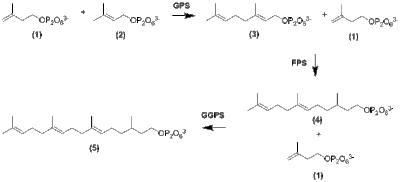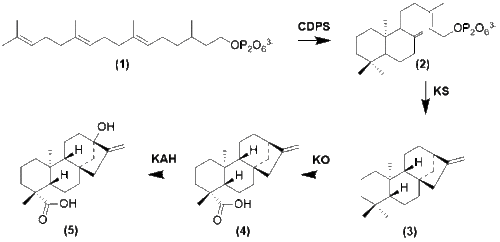Steviol glycoside

Steviol glycosides are the
Steviol glycosides from Stevia rebaudiana have been reported to be between 30 and 320 times sweeter than sucrose,[2] although there is some disagreement in the technical literature about these numbers.[1][3] They are heat-stable, pH-stable, and do not ferment.[2]
Steviol glycosides do not induce a
Structure

These compounds are
.The steviol glycosides found in S. rebaudiana leaves, and their dry weight percentage, include:
- Stevioside (5–10%)
- Dulcoside A (0.5–1%)
- Rebaudioside A (2–4%)
- Rebaudioside B
- Rebaudioside C (1–2%)
- Rebaudioside D
- Rebaudioside E
- Rebaudioside F
- Rubusoside
- Steviolbioside
The last three are present only in minute quantities, and rebaudioside B has been claimed to be a byproduct of the isolation technique.[2] A commercial steviol glycoside mixture extracted from the plant was found to have about 80% stevioside, 8% rebaudioside A, and 0.6% rebaudioside C.[3]
The Chinese plant Rubus chingii produces rubusoside, a steviol glycoside not found in Stevia.[1] According to the EU Stevia Regulation of 13 July 2021, however, rubusoside is one of the eleven major glycoside components of Stevia, extracted from the leaves of the Stevia rebaudiana.[7]
Stevioside and rebaudioside A were first isolated in 1931 by French chemists, Bridel and Lavielle.[8] Both compounds have only glucose subgroups: stevioside has two linked glucose molecules at the hydroxyl site, whereas rebaudioside A has three, with the middle glucose of the triplet connected to the central steviol structure.
Early sensory tests led to claims that rebaudioside A was 150 to 320 times sweeter than sucrose, stevioside was 110 to 270 times sweeter, rebaudioside C 40 to 60 times sweeter, and dulcoside A 30 times sweeter.[2] However, a more recent evaluation found rebaudoside A to be about 240 times sweeter, and stevioside about 140 times.[1] Rebaudioside A also had the least bitterness and aftertaste.[2] The relative sweetness seems to vary with concentration: a mix of steviol glycosides in the natural proportions was found to be 150 times sweeter than sucrose when matching a 3% sucrose solution, but only 100 times sweeter when matching a 10% sucrose solution.[3]
Biosynthesis
In

Though there are several

Upon forming IPP and DMAPP, the diterpene GGPP is formed by via head-to-tail addition by an Sn1 mechanism. Elongation begins when IPP and DMAPP form Geranyl Pyrophosphate (GPP). GPP elongates through the same Sn1 mechanism to create Farnesyl Pyrophosphate (FPP), and FPP elongates to form GGPP.

With the formation of GGPP cyclization occurs by

Steviol glycoside biosynthesis then follows several modifications from steviol that regioselectively select for sugar molecules to be placed.[13] Once these molecules are fully glycosylated, the glycosides are then stored in vacuoles.[1]
See also
References
- ^ PMID 17397883. Archived from the original(PDF) on 2017-08-10.
- ^ doi:10.4141/P97-114.
- ^ S2CID 38718610.
- PMID 16569078.
- PMID 29982648.
- ^ COMMISSION REGULATION (EU) 2021/1156 of 13 July 2021
- Comptes rendus de l'Académie des sciences(Parts 192): 1123–1125.
- ^ Huxtable, R.J., 2002. Pharmacology and toxicology of stevioside, rebaudioside A, and steviol. In: Kinghorn, A.D. (Ed.), Stevia: The Genus Stevia. Taylor and Francis, London and New York, pp.160–177.
- ^ Lichtenhalter, H.K., 1999. The 1-deoxy-D-xylulose-5-phosphate pathway of isoprenoid biosynthesis in plants. Annu. Rev. Plant Physiol. PlantMol. Biol. 50, 47–65.
- ^ Totté, N., Charon, L., Rohmer, M., Compernolle, F., Baboeuf, I., Geuns, J.M.C., 2000. Biosynthesis of the diterpenoid steviol, an ent-kaurene derivative from Stevia rebaudiana Bertoni, via the methylerythritol phosphate pathway Tetrahedron Letters 41, 6407–6410
- ^ Richman, A.S., Gijzen, M., Starratt, A.N., Yang, Z., Brandle, J.E., 1999. Diterpene synthesis in Stevia rebaudiana: recruitment and up-regulationof key enzymes from the gibberellin biosynthetic pathway The Plant Journal 19, 411–421.
- ^ Richman, A., Swanson, A., Humphrey, T., Chapman, R., McGarvey, B., Pocs, R., Brandle, J., 2005. Functional genomics uncovers threeglucosyltransferases involved in the synthesis of the major sweetglucosides of Stevia rebaudiana Plant J. 41, 56–67
External links
 Media related to Steviol glycosides at Wikimedia Commons
Media related to Steviol glycosides at Wikimedia Commons
